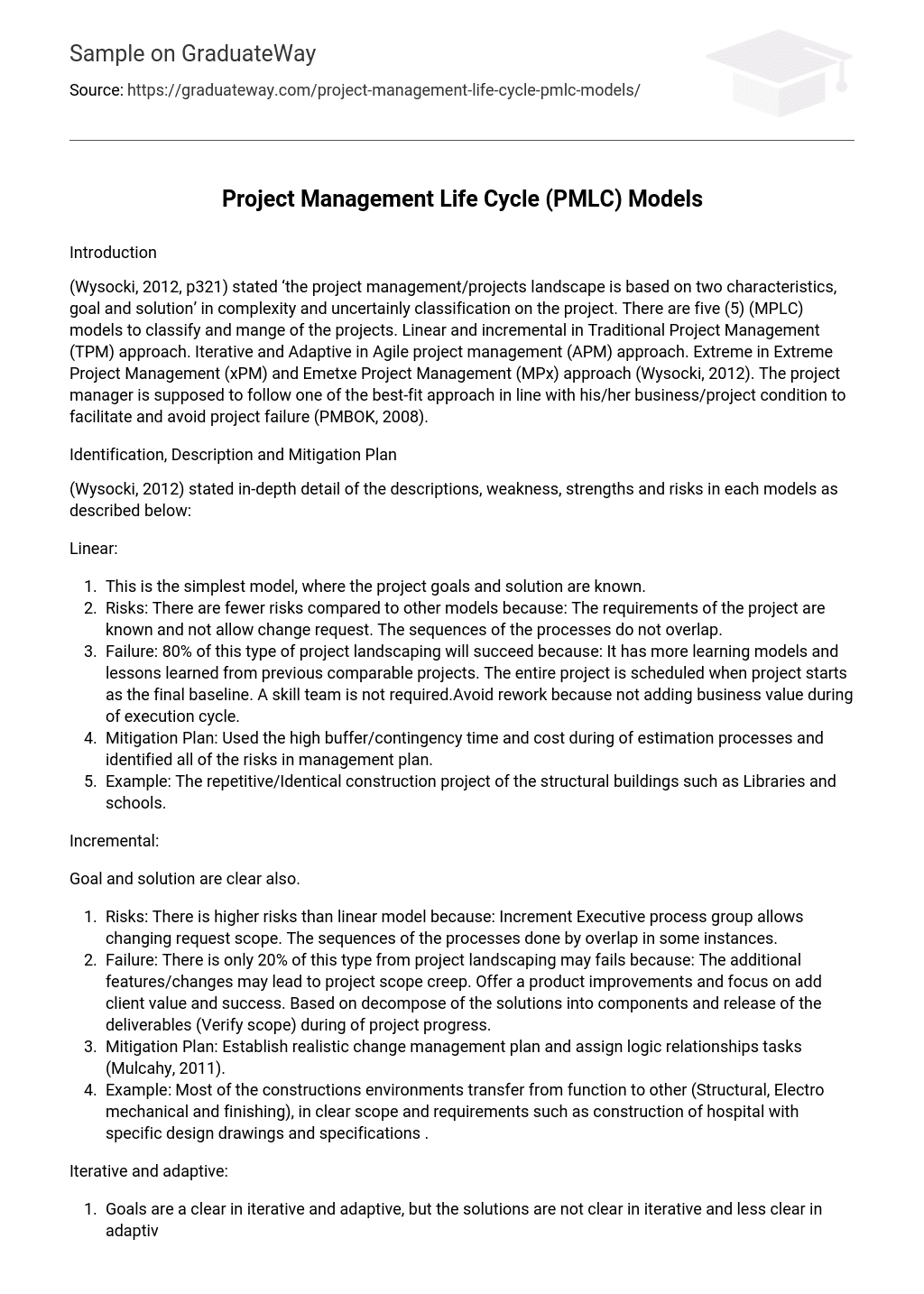Introduction
(Wysocki, 2012, p321) stated ‘the project management/projects landscape is based on two characteristics, goal and solution’ in complexity and uncertainly classification on the project. There are five (5) (MPLC) models to classify and mange of the projects. Linear and incremental in Traditional Project Management (TPM) approach. Iterative and Adaptive in Agile project management (APM) approach. Extreme in Extreme Project Management (xPM) and Emetxe Project Management (MPx) approach (Wysocki, 2012). The project manager is supposed to follow one of the best-fit approach in line with his/her business/project condition to facilitate and avoid project failure (PMBOK, 2008).
Identification, Description and Mitigation Plan
(Wysocki, 2012) stated in-depth detail of the descriptions, weakness, strengths and risks in each models as described below:
Linear:
- This is the simplest model, where the project goals and solution are known.
- Risks: There are fewer risks compared to other models because: The requirements of the project are known and not allow change request. The sequences of the processes do not overlap.
- Failure: 80% of this type of project landscaping will succeed because: It has more learning models and lessons learned from previous comparable projects. The entire project is scheduled when project starts as the final baseline. A skill team is not required.Avoid rework because not adding business value during of execution cycle.
- Mitigation Plan: Used the high buffer/contingency time and cost during of estimation processes and identified all of the risks in management plan.
- Example: The repetitive/Identical construction project of the structural buildings such as Libraries and schools.
Incremental:
Goal and solution are clear also.
- Risks: There is higher risks than linear model because: Increment Executive process group allows changing request scope. The sequences of the processes done by overlap in some instances.
- Failure: There is only 20% of this type from project landscaping may fails because: The additional features/changes may lead to project scope creep. Offer a product improvements and focus on add client value and success. Based on decompose of the solutions into components and release of the deliverables (Verify scope) during of project progress.
- Mitigation Plan: Establish realistic change management plan and assign logic relationships tasks (Mulcahy, 2011).
- Example: Most of the constructions environments transfer from function to other (Structural, Electro mechanical and finishing), in clear scope and requirements such as construction of hospital with specific design drawings and specifications .
Iterative and adaptive:
- Goals are a clear in iterative and adaptive, but the solutions are not clear in iterative and less clear in adaptive model.
- Risks: There are more risks than above descried models because; Iterative planning, Monitoring, controlling and closing process group are progressively elaborated with lack of the client involvement.
- Failure: There are 70% of projects are best managed by process, and there is No criterion to success because of iterative solutions until end and approval by the client.
- Mitigation Plan: Formal documentations and Justification. Distribution of the role and responsibility in early stages. Assigned date ceiling and specific number of submittals. Prototyping approach (MBOOK, 2008).
- Example: Design phase in construction environment has iterative process before and during the execution of the works.
Iv- Extreme:
- Goals are not clear and solutions are clear in (MPx). No goals and solutions clear in (xPM).
- Risks: This has the highest risks of all models because:
Iterative changes from initial to closing process group are progressively elaborated and No guarantee about any acceptable deliverables from the client. - Failure: This has the highest investment rating failure because the non-existence of goals, plans and solutions when starting.
- Mitigation Plan: More involvement from Expert judgments, Industrial experts and the Client. Building and motivation of the project team on inventive (Mulcahy, 2011). Building specific protocols to follow by some project team.
- Example: software improvements and researches (Mulcahy, 2011).
References.
- Mulcahy,R. (2011) PMP Exam Prep, 7th Edition. United State America: RMC.Project Management .
- Project management institute. (2008), A guide to the Project Management Body of Knowledge ,4th Edition.
- Newtown Suuqre, Pennsylvania 19073-3299USA:PMI. Wysocki, R.K., 2012, Effective Project Management: Traditional Agile, Extreme. 6TH Edition. Indianapolis: Wiley Publishing.
- Wysocki, R.K., 2012, Effective Project Management: Traditional Agile, Extreme. 6TH Edition. Indianapolis: Wiley Publishing.





